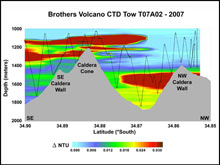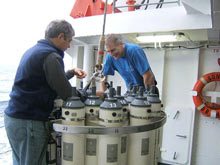A cross-section of Brothers Volcano, from northwest to southeast. The concentration of hydrothermal particles (“ΔNTU”) is given by the color scale. The thin black line traces the conductivity-temperature-depth (CTD) path. The plume distribution indicates that large vent fields are located on the northwest caldera wall and on the volcano summit. Click image for larger view and image credit.
Ed Baker (left) and Cornel de Ronde examine the CTD package before its deployment at Brothers Volcano. Click image for larger view and image credit.
Exploring for Hydrothermal Systems on Brothers Volcano
August 5, 2007
Edward T. Baker
Supervisory Oceanographer
NOAA Vents Program, PMEL – Seattle, Washington
Studying hydrothermal vent sites on Brothers Volcano requires a variety of complementary exploration strategies. On the largest scale, we need a volcano-wide view of where venting is concentrated. With that information, we can program the autonomous underwater vehicle (AUV) to produce startlingly detailed maps of the volcano terrain where the vent sources likely lie. Using the AUV data as roadmap's, the remotely operated vehicle (ROV) pilots can then accurately home in on the vent targets to obtain samples of sulfide minerals and vent fluids.
The cross-section of Brothers Volcano (as seen in the illustration) shows the first results of our volcano-wide search for hydrothermal venting. Just as your eye might be drawn from a trail of wind-blown smoke draws to a smokestack, oceanographers use maps of hydrothermal plume tracers that lead back towards a field of vents. The tracers can be physical measurements such as changes in temperature, salinity, and optical characteristics of the water. Chemical characteristics of the plume are also used, including the presence of various trace metals and gases common in a hydrothermal discharge. The basic tool, used by oceanographers around the world, consists of a conductivity-temperature-depth (CTD) package combined with sampling bottles that can be closed on demand. Added to this package are specialized sensors that can detect specific hydrothermal tracers.
The tracer (mapped in the figure) is optical backscattering, a measure of the concentration of microscopic sulfide particles suspended in the hydrothermal discharge. We mapped the plumes by towing the CTD package through the water column, raising and lowering it as we steamed across the volcano. The thin black lines in the figure show the resulting path. From these data we see two general areas of active venting within the volcano. One is located along the slopes of the caldera walls in the northwest quadrant of Brothers. The optical plume is most intense between about 1,500 and 1,600 meters (about 5,100 feet), implying that vents are scattered throughout the upper half of the wall.
The second area is the summit of the new volcanic cone rising from within the caldera (depression). Several distinct plume layers can be seen streaming away from the cone summit heights, all at depths less than about 1,300 meters. Most likely, there is a sequence of vent fields at different depths on the cone’s upper reaches. These plumes also provide some interesting additional information about water movement around Brothers. The observation that these shallow plumes are all carried southward from the volcano suggests that the broad flow of water here is dominantly southerly. In fact, we found traces of these plumes on CTD casts more than 15 kilometers (8 nautical miles) south of Brothers.
The CTD transect in the figure took only a few hours to complete, but has served to greatly economize the planned AUV and ROV deployments. We can now focus the work of these valuable tools on the volcano summit and northwest caldera walls. While we plan to map the entire caldera with the AUV, we are prioritizing the first dives on these critical areas in case weather or equipment difficulties curtail our surveys. And the very first dive with the brand new ROV was directed at the northwest caldera wall. Stand by as we use our arsenal of exploration techniques to reveal the hydrothermal mysteries of Brothers Volcano.
Sign up for the Ocean Explorer E-mail Update List.


















